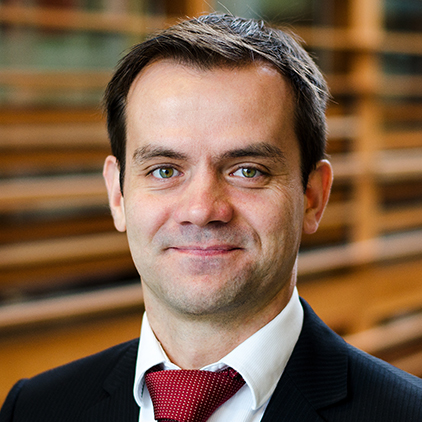Teamwork in a Post-Pandemic World
As we re-imagine the future of work, the importance of “the team” will only grow. Our experts weigh in on what that means and how to succeed

Well into the pandemic’s second year, we are beginning to see light on the horizon. But how will we communicate and work with our teams when normal life starts to return? During the pandemic, team leaders played a critical role in building and maintaining trust and connection within a virtual environment. So, what is the key to sustain team cohesion in a post-pandemic workplace–be it in-person, virtual or hybrid?
In this installment of our four-part series on the future of work, we dive into teamwork. We asked four business leaders and professors for their ideas on how we can build back better.

Strive for a balance of autonomy and belongingness
Working remotely has affected us all in many different ways. But what should organizations be doing next to promote effective teamwork?
As we come out of the pandemic, I believe teams should work towards a state in which both the experience of autonomy and belongingness can be realized. We need to maintain the freedom that employees currently have to decide where they want to work and when they want to work. But we must also address loneliness, fatigue or even depression—all of which were frequently reported during the pandemic.
Research on teams finds that autonomy can paradoxically co-exist with belongingness and cohesiveness. There are five structural dimensions on which teamwork can be designed:
- Teams can have a strong leader or share leadership responsibilities.
- Teams can have clearly defined task interdependencies and interfaces between team members. Or team members can perform their work largely in isolation.
- Teams can have the same goals and rewards for all members. Or they can offer individualized goals and rewards.
- Teams can communicate virtually or do so face-to-face.
- Teams can have a shared history and destiny. Or they can operate for a limited time, after which they disband.
Organizations need to find a balance across all five of these structural dimensions. As long as we are operating in a virtual setting, it is important to define clear interdependencies, have leaders who step up, emphasize shared goals and rewards, and have a shared future of the team to complement the larger degree of autonomy that we experience through virtual teamwork.
Looking ahead, few organizations will maintain an all-virtual presence. Many will move towards a hybrid model. For those teams that return to the office, it will be important to protect the strengths of virtual work: uninterrupted time for strategically important projects and respect for personal socializing preferences.
What else? We must eliminate “presenteeism”—showing up to work when sick. If we learn to watch our bodies and to protect ourselves and our team members from the consequences of illness, then this pandemic will have made teams not only more resilient, but also wiser and healthier.
Matthias Spitzmuller is Distinguished Professor of Organizational Behaviour at Smith School of Business.

Hardwire your culture for the “new normal”
What can we expect to outlast the pandemic in the workplace? A few things come to mind: The remote and in-office workforce; flexible schedules; and personalized work experiences. Yes, all that and delivering work faster than ever are here to stay. As we move ahead, the lessons from the last year must be hardwired into company culture. How? Through the design of work, organizational policies and the reinforcement of new management capabilities.
At the Canadian Red Cross, we are doing that. We’re strengthening our employee and volunteer communications through the use of pulse surveys, webinars and task forces. We are learning that we can unleash capacity by making work easier—evaluating workflows, providing technology and ensuring role and decision-making clarity.
But there’s more. One workplace capability that I see gaining prominence is organizational network analysis. It can help businesses understand how employees interact with one another and how work gets done. By identifying important connections and barriers in information flow, organizations can be deliberate in building social ties amongst their workforce and increase operational effectiveness.
Additionally, the onboarding experience will need to be redesigned to build team cohesion and create an understanding of cultural norms in a remote workplace. Equity in how opportunities are given and performance is evaluated will also be critical, though challenging for managers. After all, managers may find themselves overseeing both remote and in-person teams. To respond effectively they will need to be intentional in how, when and with whom they communicate and how they evaluate performance based on outcomes. Becoming attuned to unconscious bias will help them navigate the challenge.
Jennifer Wenzel is senior director, people services strategy and organizational effectiveness, at the Canadian Red Cross Society.

Lead with intention
If a pandemic had to happen, we’re fortunate it occurred in 2020 and not a decade before. The operational continuity we’ve seen—with businesses, schools, communities and social connections operating virtually—was only possible because of the recent emergence of powerful virtual collaboration platforms.
With these tools, many organizations barely missed a beat. Many say they aren’t going back. Virtual and hybrid workplaces—with some workers in offices, others at home—are here to stay. But the transition has not gone smoothly everywhere. The mere existence of collaboration tools does not guarantee success. So, what is the key to build and sustain virtual and/or hybrid teams? The answer: intentionality. Leading a team of remote workers requires forethought about communication and collaboration. Successful virtual leaders are intentional in planning communications and workflow. All team members have access to the information they need.
As we move forward, workplace communication must be abundant—and visually documented, ideally in shared workspaces (not email). Leaders need to set up a virtual collaboration architecture coupled with communication norms around using team message channels, case management notes, wikis, or other freely-accessible communication modes.
Maintaining social bonds and shared purpose also requires intentionality. Unless leaders intentionally plan team social events and regularly highlight the team’s goals and purpose, remote workers will begin to feel disengaged. With hybrid teams, it is important to include everyone in virtual bonding events to avoid workplaces fracturing into in-groups and out-groups.
Leaders who intentionally plan their virtual communication architectures, along with virtual events that foster cohesion and purpose, will ultimately be more successful in post-pandemic workplaces.
Jana Raver is the E. Marie Shantz Professor of Organizational Behaviour at Smith School of Business

Make a strategic human resources shift
We’re entering a new age of work. Organizations that can shift their focus from hierarchical employee relationships to networks of teams will be able to keep up with the demands of change and outperform their competition.
Moving from manager-employee relationships to team networks will require a change in strategic human resources. For example, rather than hiring people with specific qualifications into defined jobs indefinitely, organizations will need to understand better the skills, abilities and strengths of each employee. Based on these profiles, employees will be deployed to one or more teams to solve current problems. They might find themselves on a core team for years and on several other teams for shorter periods, depending on the organization’s needs.
Training for employees to become better team performers will be necessary. Research by Google into what makes an effective team discovered that who was on a team mattered much less than how a team operated. One of the major elements of successful teams was “equal conversational turn-taking.” In other words, in meetings, every member contributed equally to the discussion. By comparison, we know that just a few people dominate the conversation in most meetings today.
As we re-imagine the future of work, the importance of “the team” will only grow. Leaders must start envisioning how that will happen within their organizations. And then make the right investments to bring it to life.
Amanda Hudson is the founder of A Modern Way to Work.
This article is one of a four-part series on working. For more, read: Leadership in a Post-Pandemic World, Inclusion in a Post-Pandemic World and Technology and the Office in a Post-Pandemic World. This article originally appeared in Smith Magazine, the alumni publication of Smith School of Business, Queen’s University.